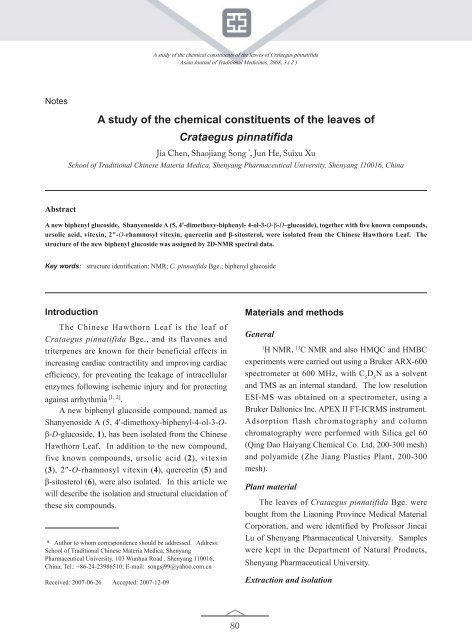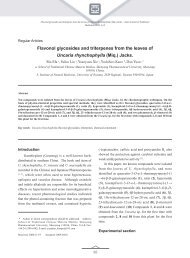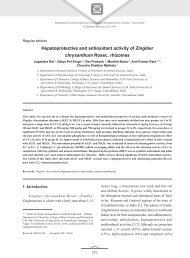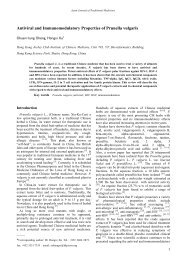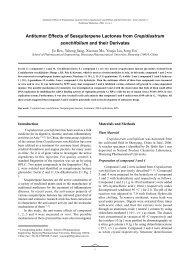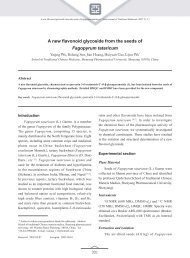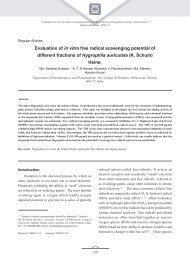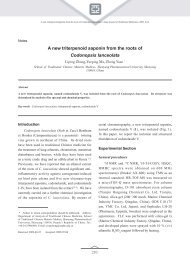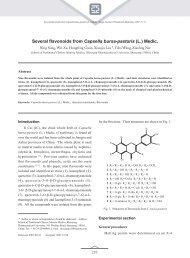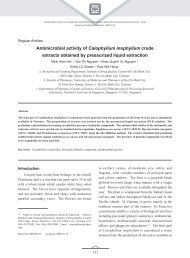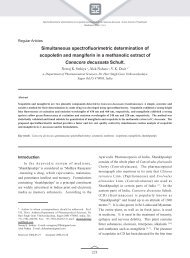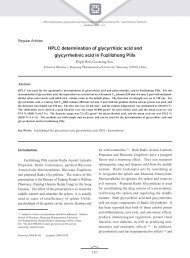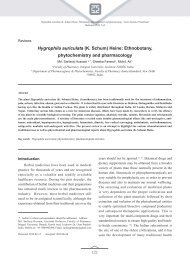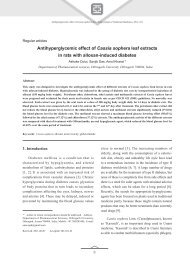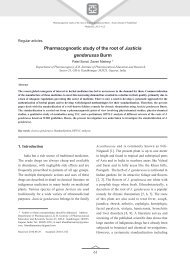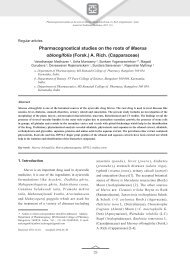A study of the chemical constituents of the leaves of Crataegus ...
A study of the chemical constituents of the leaves of Crataegus ...
A study of the chemical constituents of the leaves of Crataegus ...
You also want an ePaper? Increase the reach of your titles
YUMPU automatically turns print PDFs into web optimized ePapers that Google loves.
A <strong>study</strong> <strong>of</strong> <strong>the</strong> <strong>chemical</strong> <strong>constituents</strong> <strong>of</strong> <strong>the</strong> <strong>leaves</strong> <strong>of</strong> <strong>Crataegus</strong> pinnatifida<br />
/ Asian Journal <strong>of</strong> Traditional Medicines, 2008, 3 ( 2 )<br />
Notes<br />
A <strong>study</strong> <strong>of</strong> <strong>the</strong> <strong>chemical</strong> <strong>constituents</strong> <strong>of</strong> <strong>the</strong> <strong>leaves</strong> <strong>of</strong><br />
<strong>Crataegus</strong> pinnatifida<br />
Jia Chen, Shaojiang Song * , Jun He, Suixu Xu<br />
School <strong>of</strong> Traditional Chinese Materia Medica, Shenyang Pharmaceutical University, Shenyang 110016, China<br />
Abstract<br />
A new biphenyl glucoside, Shanyenoside A (5, 4'-dimethoxy-biphenyl- 4-ol-3-O-β-D–glucoside), toge<strong>the</strong>r with five known compounds,<br />
ursolic acid, vitexin, 2"-O-rhamnosyl vitexin, quercetin and β-sitosterol, were isolated from <strong>the</strong> Chinese Hawthorn Leaf. The<br />
structure <strong>of</strong> <strong>the</strong> new biphenyl glucoside was assigned by 2D-NMR spectral data.<br />
Key words: structure identification; NMR; C. pinnatifida Bge.; biphenyl glucoside<br />
Introduction<br />
The Chinese Hawthorn Leaf is <strong>the</strong> leaf <strong>of</strong><br />
<strong>Crataegus</strong> pinnatifida Bge., and its flavones and<br />
triterpenes are known for <strong>the</strong>ir beneficial effects in<br />
increasing cardiac contractility and improving cardiac<br />
efficiency, for preventing <strong>the</strong> leakage <strong>of</strong> intracellular<br />
enzymes following ischemic injury and for protecting<br />
against arrhythmia [1, 2] .<br />
A new biphenyl glucoside compound, named as<br />
Shanyenoside A (5, 4'-dimethoxy-biphenyl-4-ol-3-Oβ-D-glucoside,<br />
1), has been isolated from <strong>the</strong> Chinese<br />
Hawthorn Leaf. In addition to <strong>the</strong> new compound,<br />
five known compounds, ursolic acid (2), vitexin<br />
(3), 2″-O-rhamnosyl vitexin (4), quercetin (5) and<br />
β-sitosterol (6), were also isolated. In this article we<br />
will describe <strong>the</strong> isolation and structural elucidation <strong>of</strong><br />
<strong>the</strong>se six compounds.<br />
* Author to whom correspondence should be addressed. Address:<br />
School <strong>of</strong> Traditional Chinese Materia Medica, Shenyang<br />
Pharmaceutical University, 103 Wunhua Road , Shenyang 110016,<br />
China; Tel.: +86-24-23986510; E-mail: songsj99@yahoo.com.cn<br />
Received: 2007-06-26 Accepted: 2007-12-09<br />
Materials and methods<br />
General<br />
1<br />
H NMR, 13 C NMR and also HMQC and HMBC<br />
experiments were carried out using a Bruker ARX-600<br />
spectrometer at 600 MHz, with C 5<br />
D 5<br />
N as a solvent<br />
and TMS as an internal standard. The low resolution<br />
ESI-MS was obtained on a spectrometer, using a<br />
Bruker Daltonics Inc. APEX II FT-ICRMS instrument.<br />
Adsorption flash chromatography and column<br />
chromatography were performed with Silica gel 60<br />
(Qing Dao Haiyang Chemical Co. Ltd, 200-300 mesh)<br />
and polyamide (Zhe Jiang Plastics Plant, 200-300<br />
mesh).<br />
Plant material<br />
The <strong>leaves</strong> <strong>of</strong> <strong>Crataegus</strong> pinnatifida Bge. were<br />
bought from <strong>the</strong> Liaoning Province Medical Material<br />
Corporation, and were identified by Pr<strong>of</strong>essor Jincai<br />
Lu <strong>of</strong> Shenyang Pharmaceutical University. Samples<br />
were kept in <strong>the</strong> Department <strong>of</strong> Natural Products,<br />
Shenyang Pharmaceutical University.<br />
Extraction and isolation<br />
80
A <strong>study</strong> <strong>of</strong> <strong>the</strong> <strong>chemical</strong> <strong>constituents</strong> <strong>of</strong> <strong>the</strong> <strong>leaves</strong> <strong>of</strong> <strong>Crataegus</strong> pinnatifida<br />
/ Asian Journal <strong>of</strong> Traditional Medicines, 2008, 3 ( 2 )<br />
The dry powdered sample <strong>of</strong> <strong>the</strong> <strong>leaves</strong> (5 kg)<br />
was extracted 3-times for 2-hour periods with 80 %<br />
alcohol-water at 70 ºC and concentrated under reduced<br />
pressure to obtain <strong>the</strong> crude extract which was <strong>the</strong>n<br />
treated with macroporous resin and <strong>the</strong> portion eluted<br />
with 55 % alcohol-water was collected. The eluted<br />
portion was concentrated under reduced pressure, and<br />
<strong>the</strong> extract (100 g) was a brownish red powder. The<br />
extract was gradient eluted with CHCl 3<br />
-MeOH on a<br />
silica gel column. Several fractions (50 ml each) were<br />
collected, and <strong>the</strong>n analyzed by TLC and combined.<br />
The CHCl 3<br />
-MeOH (10:1) eluates were subjected to<br />
repeated silica gel column chromatography (petroleum<br />
e<strong>the</strong>r- acetoacetate; 1:1) to afford β-sitosterol (8.3<br />
mg) and ursolic acid (5.6 mg). The CHCl 3<br />
-MeOH<br />
(8:1) eluates were purified by ODS reverse phase<br />
column chromatography (H 2<br />
O-MeOH; 1:1) to obtain5,<br />
4'-dimethoxy-biphenyl-4-ol-3-O-β-D–glucoside<br />
(25.2 mg). Also, <strong>the</strong> CHCl 3<br />
-MeOH (5:1) eluates<br />
were subjected to repeated column chromatography<br />
followed by polyamide column chromatography (H 2<br />
O-<br />
MeOH; 10:1-1:1), <strong>the</strong>n fur<strong>the</strong>r purified by Sephadex<br />
LH-20 column chromatography (H 2<br />
O-MeOH; 1:1) to<br />
obtain <strong>the</strong> o<strong>the</strong>r two compounds, vitexin (19.8 mg)<br />
and 2″-O-rhamnosyl vitexin (10.6 mg).<br />
Results and discussion<br />
Six compounds were isolated from <strong>the</strong> 80 % alcohol<br />
extract. These were: 5,4'-dimethoxy- biphenyl-4-<br />
ol-3-O-β-D-glucoside (1), ursolic acid (2), vitexin<br />
(3), 2″-O-rhamnosyl vitexin (4), quercetin (5)<br />
and β-sitosterol (6). The structures <strong>of</strong> <strong>the</strong> known<br />
compounds were identified by comparing <strong>the</strong>ir<br />
properties (m.p., MS, IR, 1 H NMR and 13 C NMR) with<br />
<strong>the</strong> reported values in <strong>the</strong> literature or by comparison<br />
with au<strong>the</strong>ntic samples. The structure <strong>of</strong> <strong>the</strong> new<br />
compound was deduced as follows.<br />
Compound 1 was obtained in <strong>the</strong> usual manner<br />
as described in <strong>the</strong> experimental section. The<br />
structure <strong>of</strong> compound 1 was elucidated by ESI mass<br />
spectrometry, 1 H and 13 C NMR spectra and 2D-NMR<br />
techniques (HMQC and HMBC).<br />
Compound 1, white power, ESI-MS showed an<br />
ion peak at m/z 409.0 [M+H] + ,431.0 [M+Na] + ,<br />
838.7 [2M+Na] + , corresponding to <strong>the</strong> formula<br />
C 20<br />
H 24<br />
O 9<br />
. Based on 1 H NMR spectra (Table 1),<br />
compound 1 had two methoxyl groups, two benzene<br />
rings and a sugar moiety. The proton singlets at 3.85<br />
and 3.67 due to <strong>the</strong> methoxyl group were attached to<br />
<strong>the</strong> benzene ring. The two doublets at δ 7.55 (d, J =<br />
1.75 Hz) and δ 7.13 (d, J = 1.75 Hz) were assigned to<br />
H<br />
OH<br />
HO<br />
4<br />
6<br />
5<br />
H<br />
O<br />
HO<br />
3<br />
H<br />
2<br />
O<br />
OH 1 3 2<br />
2 3<br />
H<br />
H<br />
HO<br />
1 1<br />
4<br />
4<br />
OCH 3<br />
H 3 CO<br />
5 6<br />
6<br />
5<br />
Fig. 1. 5, 4'-dimethoxy-biphenyl-4-ol-3-O-β-D- glucoside<br />
81
A <strong>study</strong> <strong>of</strong> <strong>the</strong> <strong>chemical</strong> <strong>constituents</strong> <strong>of</strong> <strong>the</strong> <strong>leaves</strong> <strong>of</strong> <strong>Crataegus</strong> pinnatifida<br />
/ Asian Journal <strong>of</strong> Traditional Medicines, 2008, 3 ( 2 )<br />
H-2 and H-6 <strong>of</strong> a 1, 3, 4, 5-tetra-substitued benzene<br />
ring, respectively. The two doublets at δ 7.66 (2H,<br />
d, J = 8.67 Hz) and δ 7.02 (2H, d, J = 8.67 Hz) were<br />
assigned to H-2′, H-6′and H-3′, H-5′ <strong>of</strong> <strong>the</strong> o<strong>the</strong>r<br />
aromatic ring. An anomeric proton at 5.61 (d, J=6.0<br />
Hz), indicating <strong>the</strong> anomeric configuration <strong>of</strong> <strong>the</strong> sugar<br />
moiety was determined to be β- on <strong>the</strong> basis <strong>of</strong> <strong>the</strong> J H-H<br />
value. The 13 C NMR spectrum <strong>of</strong> compound 1 showed<br />
signals <strong>of</strong> two methoxyl group carbons at 56.46 and<br />
55.24, and an anomeric carbon <strong>of</strong> a sugar at 104.86.<br />
The 1 H NMR and 13 C NMR spectral data (Table 1)<br />
showed that compound 1 was a biphenyl with one<br />
sugar moiety. This sugar moiety was identified as<br />
glucose by co-TLC with au<strong>the</strong>ntic samples after acid<br />
hydrolysis. The sugar linkage was determined on <strong>the</strong><br />
basis <strong>of</strong> <strong>the</strong> HMBC spectrum. The HMBC correlation<br />
was observed between <strong>the</strong> proton signal at 5.61 (Glc-<br />
H -1",d, J=6.0 Hz) and <strong>the</strong> carbon signal at 147.59<br />
(C-3) <strong>of</strong> <strong>the</strong> aglycone moiety. In <strong>the</strong> HMBC spectra,<br />
<strong>the</strong> proton at δ 7.02 showed correlations with δ 134.20<br />
(C-1′) and δ 159.25 (C-4′), while <strong>the</strong> proton at δ 7.66<br />
showed correlations with δ 131.74 (C-1) and δ 159.25<br />
(C-4′). The proton at δ 7.55 showed correlations with<br />
δ 106.80 (C-6), δ 138.60 (C-4), δ 134.20 (C-1′) and<br />
δ 147.59 (C-3), while <strong>the</strong> proton at δ 7.13 showed<br />
correlations with δ 110.93 (C-2), δ 134.20 (C-1′), δ<br />
138.60 (C-4) and δ 149.90 (C-5), indicating that <strong>the</strong><br />
two benzene rings were linked at positions 1 and 1′.<br />
Comparing <strong>the</strong> literature [4] and <strong>the</strong> HMQC and HMBC<br />
spectral (Fig. 2) data, <strong>the</strong> structure <strong>of</strong> compound 1 was<br />
confirmed as 5, 4'-dimethoxy-biphenyl-4-ol-3-O-β-Dglucoside.<br />
Table 1. 1 H and 13 C NMR (300HMz, pyridine-d 5<br />
) spectra data <strong>of</strong> compound 1<br />
No. 1<br />
H NMR (in pyr-d 5<br />
)<br />
13<br />
C NMR (in pyr-d 5<br />
)<br />
1 131.74<br />
2 7.55(d, J=1.75 Hz) 110.93<br />
3 147.59<br />
4 138.60<br />
5 149.90<br />
6 7.13(d, J=1.75 Hz) 106.80<br />
1′ 134.20<br />
2′ 7.66(d, J=8.67 Hz) 128.17<br />
3′ 7.02(d, J=8.67 Hz) 114.65<br />
4′ 159.25<br />
5′ 7.02(d, J=8.67 Hz) 114.65<br />
6′ 7.66(d, J=8.67 Hz) 128.17<br />
5 -OCH 3<br />
3.85(s) 56.46<br />
4′-OCH 3<br />
3.67(s) 55.24<br />
Glc -1" 5.61(d, J=6.0 Hz) 104.86<br />
2" 4.37 75.15<br />
3" 4.08 79.19<br />
4" 4.32 71.30<br />
5" 4.41 78.52<br />
6" 4.55 62.36<br />
82
A <strong>study</strong> <strong>of</strong> <strong>the</strong> <strong>chemical</strong> <strong>constituents</strong> <strong>of</strong> <strong>the</strong> <strong>leaves</strong> <strong>of</strong> <strong>Crataegus</strong> pinnatifida<br />
/ Asian Journal <strong>of</strong> Traditional Medicines, 2008, 3 ( 2 )<br />
H<br />
HO 4''<br />
HO<br />
OH<br />
6''<br />
H<br />
5''<br />
H 2''<br />
3''<br />
H<br />
O<br />
OH 1''<br />
H<br />
HO<br />
O<br />
4<br />
3<br />
2<br />
H<br />
1<br />
H<br />
1'<br />
2' 3'<br />
H<br />
4'<br />
OCH 3<br />
H 3 CO<br />
5 6<br />
H<br />
H<br />
6'<br />
5'<br />
H<br />
show HMBC correlation<br />
Fig. 2. <strong>the</strong> key HMBC correlation <strong>of</strong> compound 1<br />
References<br />
[1] Handel AM. <strong>Crataegus</strong>. Toxikologie and pharmakologie<br />
teil II: pharmkodynamik. Plant Med, 1981: 43(3): 209-39.<br />
[2] Kashnikova MV. Sheichenko VI acetylytexin - a new<br />
flavonoid from <strong>the</strong> flowers <strong>of</strong> crataegus sanguines. Khim<br />
Prir Soedin, 1984: 1: 108-9.<br />
[3] Chen J, Song SJ. Research progress in <strong>Crataegus</strong><br />
pinnatifida Bge. Research and Information on Traditional<br />
Chinese Medicine, 2005: 7: 20-23, 26.<br />
[4] Teanette GG. Atlas <strong>of</strong> Spectra Data and physical Constance<br />
for organic compounds, 2nd, 1975: 284.<br />
83


